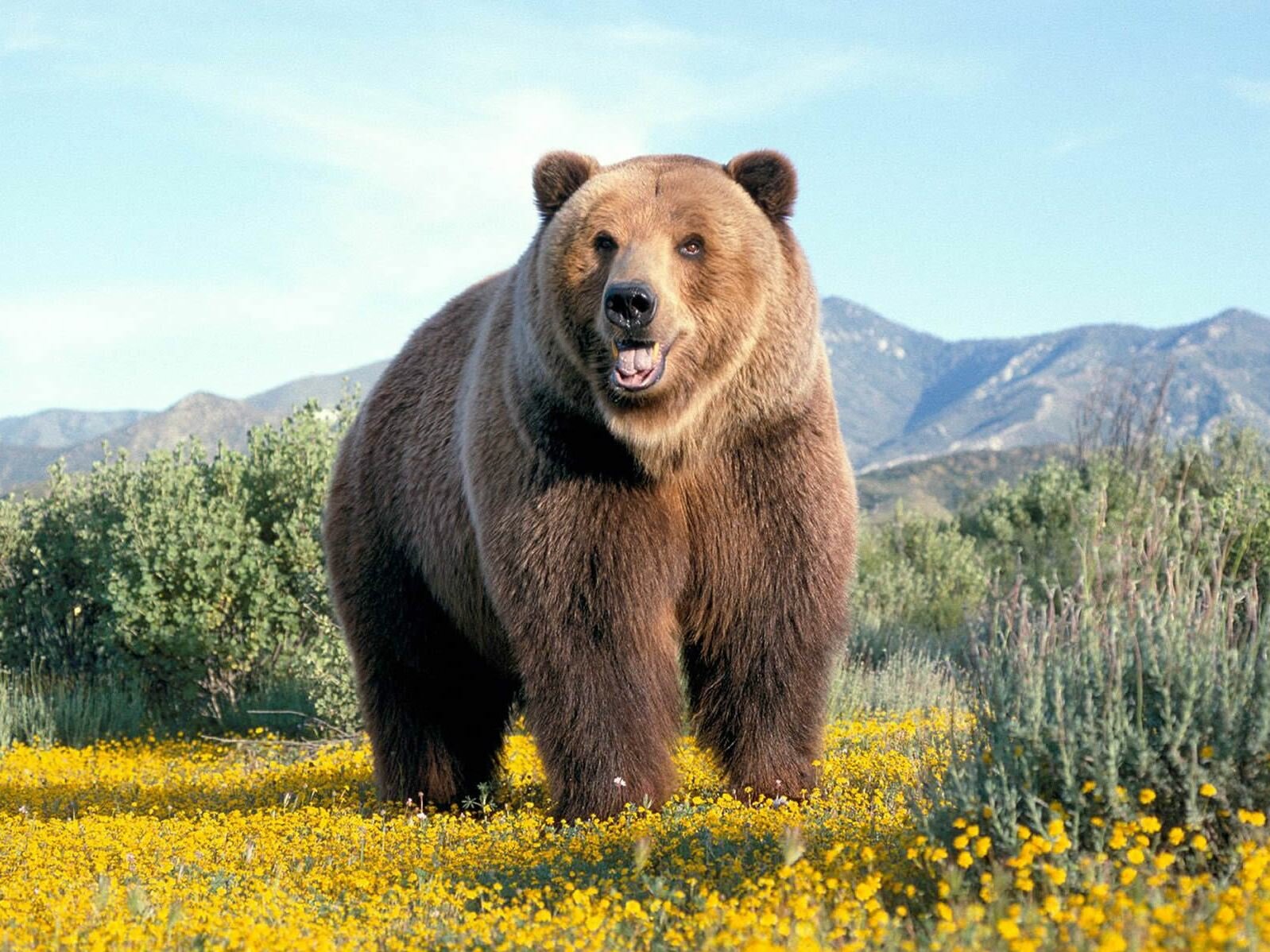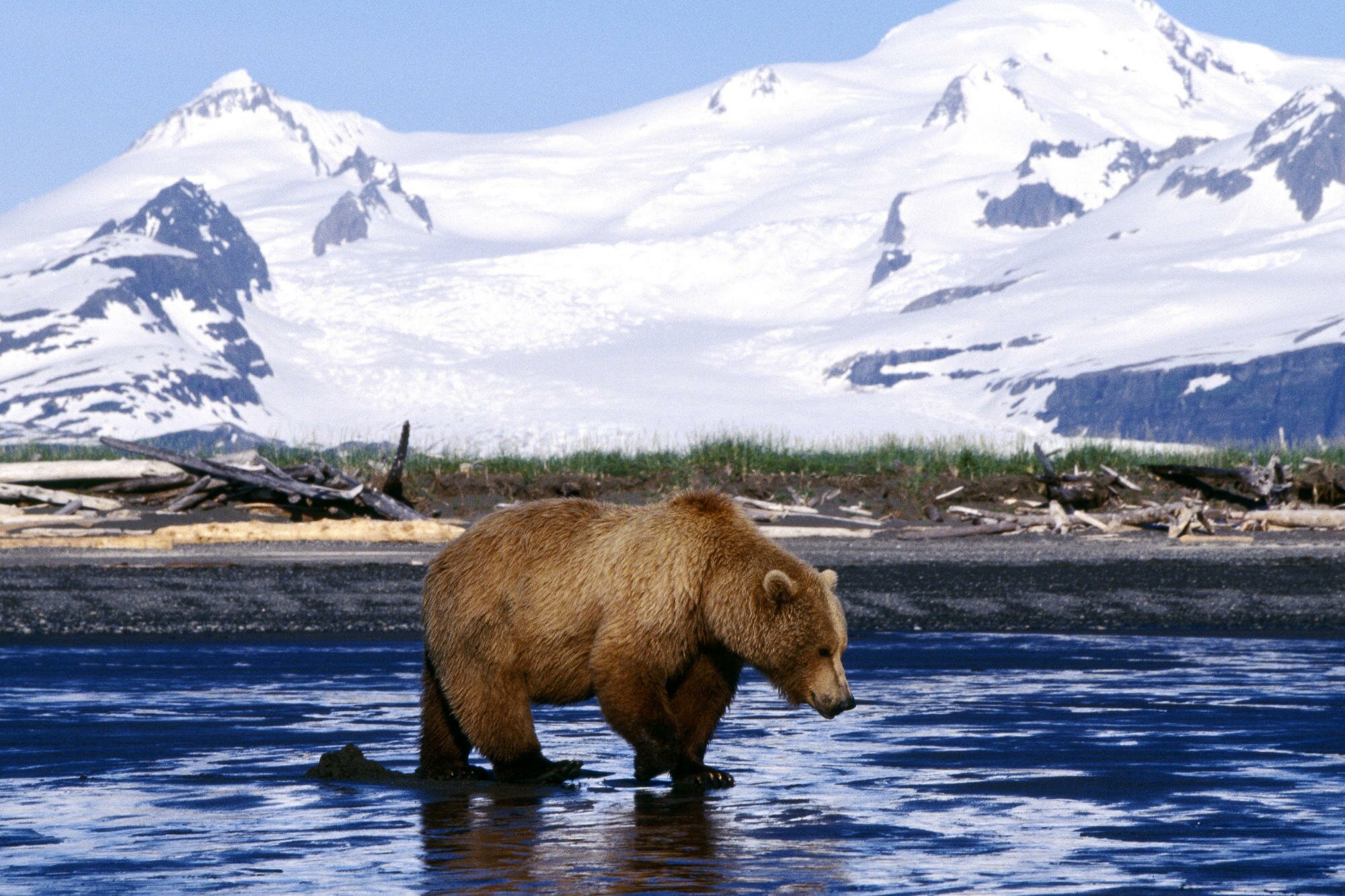Brown bear
| Latin name: |
Ursus arctos |
| Family: |
Bear |
A brown bear, or an ordinary bear, is a predatory mammal of the bear family; One of the largest and most dangerous land predators. Distribution Once a brown bear was common throughout Europe, including England and Ireland, in the south its range reached northwest Africa (Atlas Mountains), and in the east through Siberia and China reached Japan. In North America, it probably hit about 40 000 years ago from Asia, through the Bering isthmus, and widely settled in the western part of the continent from Alaska and to the north of Mexico. Now the brown bear is exterminated on a large part of the former range; In the remaining areas is small. In Western Europe, its disunited populations have been preserved in the Pyrenees, the Cantabrian Mountains, the Alps and the Apennines. It is quite common in Scandinavia and Finland, sometimes found in the forests of Central Europe and in the Carpathians. In Finland it is declared a national animal. In Asia it is spread from the Near East, Palestine, northern Iraq and Iran to the north of China and the Korean peninsula. In Japan it is found on the island of Hokkaido. In North America, known as the "grizzly" (before the North American brown bear was isolated as a separate species), it is numerous in Alaska, in western Canada, and there are limited populations in the northwest of the United States. The brown bear habitat in Russia occupies almost the whole forest zone, except for its southern regions. The northern boundary of the range coincides with the southern boundary of the tundra.
Appearance Brown bear forms several subspecies (geographical races), differing in size and color. The smallest individuals are found in Europe, the largest - in Alaska and Kamchatka - they weigh 500 and more kg; Came across giants weighing 700-1000 kg. The maximum recorded weight of the male of the Kamchatka bear was 600 kg, the average weight was 350-450 kg. There is information that in autumn the weight of especially large Kamchatka individuals exceeds 700 kg. The largest bear, caught on the island of Kodiak for the Berlin Zoo, weighed 1134 kg. The length of the European brown bear is usually 1,2-2 m, with the height at the withers about 1 m and the mass from 300 to 400 kg; Grizzly much larger - some individuals, standing on their hind legs, reach a height of 2,8-3 m; Bears living in the central strip of Russia, weigh 400-600 kg. Adult males are, on average, 1,6 times larger than females. The shape of a brown bear is typical of a bear family. His body is powerful, with a high withers; The head is massive with small ears and eyes. The tail is short - 65-210 mm, barely visible from the wool. Paws strong with powerful, non-clawing claws of length 8-10 cm, five-fingered, stop-over. The coat is thick, evenly colored. The color of the brown bear is very variable, not only in different parts of the range, but also within the same region. The color of the fur varies from light pale to bluish and almost black. The most common is the brown form. In Grizzly Grizzly, hair on the back can be white at the ends, giving the impression of a gray or gray hue of wool. Whole gray-white color occurs in brown bears in the Himalayas, and pale reddish-brown in Syria. Bear cubs on the neck and chest have bright marks, which disappear with age. Moulting in brown bears occurs once a year - begins in spring and until autumn, but often it is subdivided into spring and autumn. Spring lasts a long time and most intensively goes in the period of the rut. Autumn molting is slow and imperceptible, ending with the period of occurrence in the den.
Lifestyle and nutrition Brown bear is a forest animal. Its usual habitats in Russia are solid forest tracts with a windbreak and gary with dense thickets of hardwoods, bushes and grasses; Can enter both the tundra and the high-mountain forests. In Europe, he prefers mountain forests; In North America it is more common in open areas - in the tundra, in alpine meadows and on the coast. The bear usually keeps solitary, the female - with cubs of different ages. Males and females are territorial, the individual site on average takes from 73 to 414 km, and in males it is about 7 times larger than in females. The boundaries of the site are marked with scent marks and "bully" - scratches on prominent trees. Sometimes he makes seasonal strolls; So in the mountains the brown bear, beginning in the spring, feeds in the valleys where the snow first descends, then goes to the loach (alpine meadows), then gradually descends into the forest belt, where berries and nuts are ripening. The brown bear is omnivorous, but its diet is 3 / 4 vegetable: berries, acorns, nuts, roots, tubers and grass stalks. In bad years for berries in northern regions, bears are visited by oats, and in the south - corn crops; In the Far East in the autumn they feed in the stone pine forests. Its diet also includes insects (ants, butterflies), worms, lizards, frogs, rodents (mice, marmots, ground squirrels, chipmunks), fish and predators. In summer, insects and their larvae sometimes make up to 1 / 3 a bear's ration. Although predation is not an exemplary strategy for brown bears, they also produce ungulates - roe deer, deer, deer, caribou, and fallow deer. Grizzlies sometimes attack wolves and barbald bears, while in the Far East brown bears can hunt Himalayan bears and tigers. Brown bear likes honey (hence the name); Eats carrion and sometimes takes away prey from wolves, pumas and tigers. Seasonal object of food is fish during spawning (passage salmonids), in early spring - rhizomes, in grizzlies living in the vicinity of the Rocky Mountains, in summer - butterflies that hide in the mountains among the stones from the summer heat. When the fish has just started arriving for spawning, the bears eat up the whole fish, then start eating only the fattest parts - skin, head, caviar and milk. In poor years of feeding, bears sometimes attack livestock, ruin apiaries. Males can hunt for their own kind of cubs, preferring males as potential competitors in the future.
The brown bear is active throughout the day, but more often in the mornings and evenings. Seasonal cyclicity of life is pronounced. By winter, the bear swallows subcutaneous fat (up to 180 kg) and falls into the den in the fall. The bergs are located in a dry place, in most cases in pits under the protection of a windbreak or under the twisted roots of trees. Less often bears dig a shelter in the ground or occupy caves and crevices of rocks. Bears have favorite wintering places, where they gather year after year from the whole district. In different areas, the winter sleep lasts from 75 to 195 days. Depending on climatic and other conditions, bears are in dens during October-November to March-April, that is, 5-6 months. Longest live in the dens of bear with bear cubs, least of all - the old males. In the south of the range, where the winter is not very snowy, the bears do not lie dormant at all. During the wintering period, the bear loses up to 80 kg of fat. Contrary to popular belief, the winter dream of a brown bear is shallow; The temperature of his body in a dream varies between 29 and 34 degrees. In case of danger, the animal wakes up and leaves the den, going in search of a new one. Sometimes a bear does not have time to fatten properly in the autumn, so wakes up among winters and starts to wander about in search of food; Such bears are called rods. Cranks are very dangerous, hunger makes them ruthless predators - they attack anyone who meets them on the road, even a person. Such bears have very few chances to live until the spring. Despite the clumsy appearance, the brown bear runs exceptionally fast - at a speed of up to 50 km / h, excellently swims and when young enough it climbs trees well (to old age, it makes it more reluctant). With one punch, a bear can break a bull's back, a bison or a buffalo.
Reproduction Females bring offspring once in 2-4 years. They last from May to July, 10-30 days. At this time, males, usually silent, begin to roar loudly, and between them there are fierce fights, sometimes ending in death; The victor can even eat the defeated. The female mates with several males. Pregnancy in a bear with a latent stage, the embryo does not begin to develop before November, when the female lies down in the den. Total pregnancy lasts 6-8 months, and birth occurs from January to March, when the female is still in hibernation. Dipper brings 2-3 (maximum to 5) bear cubs weighing 340-680 g and length up to 25 cm, covered with a short sparse wool, blind, with an overgrown acoustical passage. The ear canals open for them on 14 day; A month later they begin to see. Already by 3 months the cubs have a full set of milk teeth and begin to eat berries, greens and insects. At this age they weigh about 15 kg; To 6 months - 25 kg. Lactation will continue for 18-30 months. The father does not engage in offspring, the bear cub is brought up by the female. Often, along with the cubs, the year-old female, the so-called pestun, helps the mother in rearing the offspring. Finally, the cubs are separated from the mother at 3-4 year of life. Sexual maturity bears reach in 4-6 years, but grow up to 10-11 years. Life expectancy in nature 20-30 years, in captivity - up to 47-50 years.
Population status and significance for humans The brown bear is listed in the Red Data Book of the IUCN as "endangered species", but its abundance varies greatly from population to population. According to rough estimates, now in the world approx. 200 000 brown bears. Most of them live in Russia - 120 000, USA - 32 500 (95% live in Alaska) and Canada - 21 750. In Europe, about 14 000 individuals survived. The commercial significance of the brown bear is small, hunting in many areas is prohibited or restricted. The skin is used mainly for carpets, meat is used for food. The gallbladder is used in traditional Asian medicine. In places, a brown bear damages crops, rakes apiaries and attacks domestic animals. Meeting with a brown bear can be deadly. As a rule, this animal avoids a person, however a close encounter, especially with a hungry connecting rod or bear with cubs, can result in death or injury. Usually, if the beast went to a man, it is advised to fall face down on the ground and not move, pretending to be dead until the beast leaves.
Protection It is listed in the Red Book of Russia. Slow reproduction and high mortality of young animals make this beast easily vulnerable. However, now the population is considered stable or even growing. At 1993, it was evaluated in 21 470-28 370 individuals. In Russia, there are 5-7 thousand polar bears, and annual poaching is from 150 to 200 individuals per year. Due to the decrease in the population of Dixon, the extermination of the polar bear is slightly reduced. In the Pleistocene epoch about 100 thousand years ago, a larger subspecies giant white bear lived, which was much larger in size.
|
|








